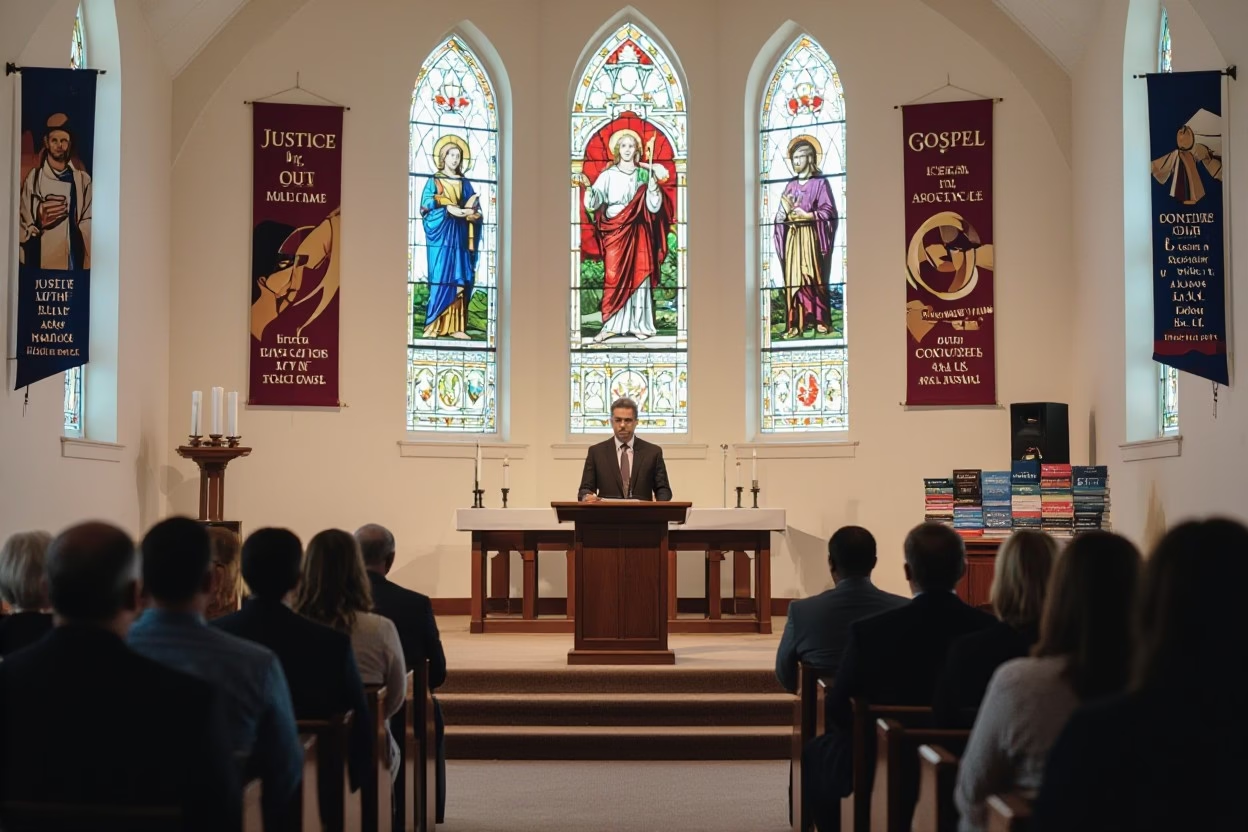Most Christians navigating the Silent Exodus from evangelicalism face a complex journey marked by suffering, doubt, and deep spiritual searching. This phenomenon, often misunderstood as mere rebellion, reflects a profound desire for authentic faith amid experiences of toxic church culture and emotional strain. By exploring historical patterns, psychological roots, and biblical insights, this comprehensive theology offers guidance for those seeking to reconstruct a resilient, honest faith. It emphasizes the church’s responsibility to respond with humility, repentance, and supportive pastoral care to foster spiritual renewal and hope.
Key Takeaways:
- Church history reveals that periods of faith crisis and renewal are recurring, with today’s deconstruction echoing past movements seeking authentic spirituality rather than mere rebellion.
- Faith crises often arise from spiritual abuse, cognitive dissonance, exposure to new ideas, and unaddressed trauma, leading believers into deep emotional and intellectual reevaluation.
- The Bible models doubt and lament as integral parts of faith, showing that honest questioning can coexist with trust and ultimately lead to encounters with God.
- Toxic dynamics within church culture, including authoritarianism and exclusion, contribute significantly to departures, necessitating systemic repentance and an apologetic of confession.
- Healthy faith reconstruction can be supported by returning to historic creeds and liturgy, practicing trauma-informed discipleship, and embracing Spirit-led growth amid deconstruction.
- Pastoral care should focus on creating safe spaces for doubt, prioritizing relationship over control, modeling humility, and helping distinguish the core gospel from cultural or secondary issues.
- Deconstruction can serve as a pathway to a more resilient and authentic Christian faith that embraces suffering, doubt, and radical grace within a communal and historical context.
Echoes of History: When Faith Collides with Institutional Failures
Scandals that Shook the Church: Historical Precedents
Throughout church history, high-profile scandals have repeatedly catalyzed waves of disillusionment and departure. The Medieval abuse scandals that surfaced in the late 20th century, for example, serve as a stark reminder of how systemic failures can erode trust on a global scale. The widespread revelation of clergy sexual abuse and subsequent institutional cover-ups undermined the moral authority of the Roman Catholic Church, prompting both believers and skeptics to reevaluate their allegiance. Similarly, the immoral behaviors of prominent leaders during the Protestant Reformation, such as corruption and indulgence sales, triggered reformers like Martin Luther to call for a return to biblical fidelity—actions that fractured centuries-old church unity and birthed major denominational shifts.
These historical precedents reveal patterns where institutional hypocrisy and a failure to protect vulnerable members provoke not just isolated crises but broad questions about the church’s spiritual legitimacy. Recent evangelical scandals involving financial mismanagement, political entanglements, and sexual misconduct echo these past failures. Each episode highlights the dissonance between professed values and lived reality, driving many to question whether the church, as an institution, adequately represents the gospel it proclaims. The trauma experienced is often compounded by the lack of transparent accountability, deepening the faith crisis for those affected.
Renewal Movements: The Quest for Authentic Faith
Amid institutional failures, renewal movements have historically arisen as prophetic responses demanding spiritual authenticity and reform. The 18th-century Great Awakening, for instance, united diverse American colonies around vigorous preaching and personal conversion, challenging the complacency and formalism of established churches. Similarly, the 19th-century Holiness and Pentecostal movements extended this quest, emphasizing personal experience of the Spirit and a faith that visibly transformed conduct and community life. These movements demonstrate how a reaction against perceived rigidity or corruption can fuel a vibrant return to heartfelt discipleship.
Such renewal efforts often prioritize inclusive community, experiential spirituality, and radical grace, contrasting with institutional control or legalism. They provide models for today’s seekers who reject toxic church cultures but yearn for connection, meaning, and transcendence rooted in historic Christian faith. Importantly, these movements did not abandon doctrine but reframed it in ways that re-engaged believers with a faith both deeply ancient and dynamically lived.
The contemporary landscape shows parallel impulses as many withdraw from evangelical frameworks yet simultaneously seek fresh expressions of faith that resonate with their struggles and questions. The ongoing relevance of renewal movements suggests the church’s ability to adapt and reform itself through Spirit-empowered renewal remains vital in addressing present-day deconstruction and reconstruction journeys.
The Psychological Tectonics of Faith Shift
Unpacking Spiritual Abuse and Its Aftermath
Spiritual abuse—often characterized by authoritarian control, manipulation, and the weaponization of doctrine—plays a significant role in the faith crises experienced by many leaving evangelicalism. Survivors frequently report feelings of betrayal, isolation, and deep mistrust toward church authorities who abused their spiritual authority or dismissed legitimate questions. This abuse manifests in rigid expectations of conformity, punitive responses to doubt, and the marginalization of vulnerable groups, creating an environment where sincere seekers feel spiritually unsafe.
The aftermath can be devastating: individuals carry wounds that extend beyond mere disillusionment into trauma that affects their emotional and relational health. Emotional estrangement from God often accompanies these wounds, producing a longing for authentic connection while simultaneously generating suspicion of institutional religion. Healthy faith reconstruction must address these psychological scars through empathy, validation of pain, and gradual restoration of trust—not by rushing adherence to orthodox frameworks or silencing difficult conversations.
The Role of Cognitive Dissonance in Faith Deconstruction
Cognitive dissonance arises when deeply held beliefs collide with lived realities, producing intense internal conflict that demands resolution. Many who undertake deconstruction wrestle with contradictions between the teachings they were raised with and the complexities of life, such as witnessing injustice, experiencing failure, or encountering scientific and historical knowledge that challenges biblical literalism. This dissonance can generate a “desert of skeptical criticism,” where old certainties crumble, and new frameworks remain elusive.
Resolving cognitive dissonance is not a linear process; it involves cycles of doubt, questioning, and tentative acceptance. Some may swing between skepticism and yearning for faith, navigating an intellectually and emotionally intense terrain. This tension can lead either to abandoning faith entirely or rebuilding a more nuanced, resilient spirituality that integrates doubt into its core. The psychological strain of cognitive dissonance underscores the necessity of safe spaces and patient discipleship that allows individuals to wrestle honestly without fear of condemnation.
Further complicating this process, cognitive dissonance often intersects with emotional pain and trauma, intensifying the crisis. The mental exertion demanded by reconciling conflicting worldviews can lead to spiritual exhaustion, requiring refuge in communal support, reflective prayer, and honest theological engagement rather than quick fixes or superficial reassurances.
Navigating New Ideologies: The Influence of Education and Digital Culture
Exposure to diverse ideas via higher education and digital platforms profoundly shapes the trajectory of faith deconstruction. Access to rigorous scholarship, historical-critical biblical studies, and global perspectives challenges inherited narratives, often dismantling simplistic or dogmatic worldviews. For example, interaction with secular ethics, comparative religion, and scientific consensus can unsettle previously unexamined assumptions about truth and morality.
Social media and online forums provide both opportunity and peril: they serve as vital spaces for questioning, community, and resource-sharing, yet also expose seekers to misinformation, ideological polarization, and echo chambers. The democratization of information expands horizons but sometimes intensifies anxiety, as conflicting voices compete without the moderating presence of trusted guides. This dynamic amplifies the psychological pressure to reassess faith, making critical thinking and discernment indispensable tools.
Moreover, digital culture accelerates cultural shifts that challenge evangelical distinctives on gender, sexuality, and social justice, prompting renewed debates within individual faith journeys. Navigating these ideological currents requires not only intellectual agility but pastoral sensitivity to how these influences affect emotional and spiritual well-being.

The Biblical Landscape: Embracing Doubt as Part of Faith
Scriptural Voices of Lament: Job and the Psalms
The Book of Job stands as one of the most profound scriptural treatments of suffering and doubt. Job’s relentless questioning—“Why did I not perish at birth?” and “Where is God in my affliction?”—expresses intense pain and confusion without masking or diluting his anguish. His candid complaints and accusations are not dismissed but ultimately commended, illustrating that honest wrestling with God is a valid and honorable posture within faith. Rather than offering pat answers, the narrative culminates in a divine encounter that acknowledges the limits of human understanding while affirming God’s sovereign presence amid suffering.
The Psalms offer a rich tapestry of lament that models raw emotion and persistent lament as integral to worship and relationship with God. Psalms such as 13, 22, and 42 sound out complaints like “How long, O Lord?” or “My God, why have you forsaken me?” These lamentations create space for believers to voice pain and confusion openly, resisting the temptation to feign unwarranted certainty. Their repeated inclusion of protest alongside trust demonstrates that doubt and struggle need not undermine faith but rather can deepen its authenticity.
The Prophet’s Struggle: Habakkuk’s Challenge to God
The prophet Habakkuk embodies the tension between divine justice and apparent injustice in the world. He openly questions God’s tolerance of violence and corruption, asking, “Why do you make me see iniquity, and why do you idly look at wrong?” This challenge to God’s governance is neither dismissed nor condemned but is recorded as a transparent dialogue, reflecting the prophet’s intense spiritual wrestling. In this dialogue, Habakkuk refuses to settle for simplistic answers and instead models a faith willing to persist in trust while pressing God for clarity and justice.
Despite the prophet’s frustration and doubt, the concluding declaration—“the righteous will live by faith”—paces a pathway forward that embraces faith not as unquestioning certainty but as committed trust amidst ambiguity. Habakkuk’s journey invites those in the Silent Exodus to acknowledge the difficulty of faith in an often opaque world and yet to choose resilience and hope in God’s ultimate justice.
Habakkuk’s candid confrontation with God and the resulting trust serve as an ancient example of faith’s capacity to hold tension between doubt and hope. This biblical witness legitimizes the experience of wrestlers and doubters alike, affirming that grappling with divine justice is not antithetical to faith but an vital part of its maturation.
Jesus in the Garden: The Theology of Suffering and Abandonment
Jesus’ agony in the Garden of Gethsemane and his cry of abandonment on the cross (“My God, my God, why have you forsaken me?”) reveal a profoundly incarnational theology of suffering. His prayers, asking to “remove this cup” while simultaneously submitting to the Father’s will, lay bare the tension between human vulnerability and divine obedience. Jesus does not embody a faith untouched by doubt or struggle; rather, he exhibits faith that persists through deep anguish and spiritual isolation.
This portrayal challenges the notion that faith requires constant emotional assurance or avoidance of dark nights of the soul. Jesus’ experience situates suffering and abandonment within the redemptive narrative itself, giving space for believers to acknowledge their own pain without shame. His example affirms that the presence of doubt or feelings of divine silence may coexist with enduring trust and ultimate hope.
Jesus’ wrestling in Gethsemane and his cry from the cross provide a foundation for understanding suffering as a meaningful dimension of faith. His embodiment of abandonment and trust establishes a theological framework that legitimizes the spiritual turmoil experienced by many deconstructing believers, assuring them that they are participating in a shared narrative of lament and hope.
The Toxic Environment: Understanding Church Dynamics
Identifying Authoritarian Structures and Their Impact
Authoritarian leadership models often concentrate power in a few individuals, frequently discouraging dissent and questioning within the congregation. This dynamic manifests in rigid hierarchical structures where leaders’ authority goes unchallenged, sometimes justified by appeals to biblical inerrancy or divine calling. Churches operating under authoritarian governance regularly suppress dialogue, foster fear of judgment, and enforce conformity through social or spiritual pressure. Such environments can lead to spiritual abuse, alienation, and a pervasive sense of isolation among members, especially those grappling with doubts or divergent perspectives.
Several studies show that authoritarian church settings correlate strongly with increased rates of burnout, depression, and exit from faith communities. For example, surveys conducted by Faith Matters Institute reveal that up to 60% of those who leave evangelicalism cite controlling leadership and punitive responses to questions as key factors. This pattern stifles healthy theological development and often conflates loyalty with uniformity, undermining the biblical witness of mutual submission and love highlighted in New Testament leadership models.
The Exclusion of Marginalized Voices: A Call for Reflection
Marginalized groups—whether due to race, gender, sexual orientation, or socio-economic status—often find themselves excluded or silenced within many evangelical contexts. This exclusion is not only manifest in formal policies but also through unspoken cultural norms, lack of representation in leadership, and dismissal of lived experiences as less theologically valid. For instance, women’s leadership is still limited in numerous evangelical circles, and crucial conversations around racial reconciliation frequently remain superficial or tokenistic. Such dynamics reinforce systemic inequalities and alienate those who might otherwise find spiritual home.
This marginalization has practical and spiritual consequences. Excluded individuals frequently report feelings of invisibility, compounded trauma, and a dissonance between their authentic self and the faith culture around them. The church risks fracturing its witness and perpetuating harm if it fails to confront these exclusions directly. Embracing diverse voices enriches theological reflection and aligns with the biblical vision of the church as a multifaceted, inclusive body (1 Corinthians 12).
Highlighting these patterns becomes imperative for churches aiming to foster authentic community. Reflective practices that invite honest engagement with histories of exclusion, coupled with intentional amplification of marginalized perspectives, can catalyze necessary transformation and healing within the body of Christ.
Systemic Repentance: Moving Beyond Individual Accountability
Addressing toxicity within church environments requires confronting systemic issues rather than focusing solely on individual failings. Patterns of authoritarianism, exclusion, and spiritual abuse often persist due to institutional cultures that prioritize reputation, numerical growth, or cultural conformity over gospel integrity. Systemic repentance involves public acknowledgment of these entrenched dynamics and commitment to structural change, not just personal apologies by leaders. This approach mirrors prophetic calls in Scripture, like those of Jeremiah and Isaiah, where communal and institutional repentance precedes renewal.
Effective systemic repentance also challenges congregations to reevaluate theological conflations that equate cultural or political identities with core gospel truths. When churches conflate secondary issues with the gospel, they erect barriers to diversity in thought and experience, deepening division and fostering distrust. By distinguishing vitals from distinctives, communities create space for healthy disagreement and inclusive dialogue, reinforcing a gospel-centered unity that can withstand complexity.
Furthermore, systemic repentance necessitates developing accountability mechanisms that redistribute power and foster transparency. For example, some congregations have instituted independent review boards, regular equity audits, and open forums for marginalized members to voice concerns safely. These institutional innovations help prevent recurrence of harm and signal a genuine commitment to repentance that moves beyond surface-level fixes.
Foundations for Reconstruction: Ancient Practices in a Modern Context
The Power of Historic Creeds and Liturgy
Historic creeds such as the Apostles’ Creed, the Nicene Creed, and the Chalcedonian Definition serve as concise theological anchors that connect believers across time and cultural shifts. For many undergoing faith reconstruction, these creeds provide a grounding framework that transcends the episodic controversies and cultural particularities which often fracture contemporary evangelicalism. They offer a distilled summary of core Christian convictions—such as the Trinity, the incarnation, and the resurrection—helping individuals move beyond divisive secondary doctrines that can obscure the gospel’s heart.
Liturgy, with its rhythm of prayers, scripture readings, and sacramental acts, fosters regular engagement with the historic Christian story and communal identity. Participation in liturgical practices invites one into embodied expressions of faith that stimulate the mind, heart, and soul in concert. This embodied worship instills a sense of permanence and continuity, contrasting with the volatility of modern evangelical subcultures. Such stability can be especially restorative for those emerging from spiritual environments marked by emotional upheaval or dogmatic rigidity.
Trauma-Informed Approaches to Faith Re-engagement
Returning to faith after deconstruction frequently involves navigating emotional wounds inflicted by prior church experiences. A trauma-informed approach acknowledges these psychological realities instead of minimizing or ignoring them. It emphasizes creating environments where safety, empathy, and trust precede theological instruction, recognizing that survivors of spiritual abuse or exclusion may carry deep relational scars that inhibit immediate participation in community or doctrine.
Methods such as allowing space for silence, validating personal experiences of pain, and pacing discipleship according to individual readiness help prevent retraumatization. This paradigm also encourages pastors and leaders to cultivate listening skills marked by compassion rather than correction, offering grace-filled accompaniment rather than rigid expectations. By prioritizing emotional healing as part of spiritual growth, trauma-informed discipleship transforms faith reconstruction into a holistic process.
Integrating insights from psychology, trauma-informed care sees faith not simply as cognitive assent but as an intricate interplay of mind, body, and spirit. Practices such as contemplative prayer, guided reflection, and communal lament allow participants to process grief and betrayal while slowly rebuilding trust in God and the church community.
Embracing Spirit-Led Discipleship: Tradition Meets Transformation
Spirit-led discipleship invites a dynamic engagement with the Holy Spirit that marries historic Christian tradition with ongoing transformation. Especially in Pentecostal and Charismatic circles, deconstruction is reframed as a necessary purging that prepares the believer for deeper spiritual maturity and vitality. This approach views doubt and struggle not as threats to faith but as refining fires that prompt dependence on the Spirit’s guidance rather than human structures or inherited ideologies.
Such discipleship often emphasizes experiential faith practices—prayer for healing, prophetic ministry, and discernment of spiritual gifts—that situate faith reconstruction within the context of ongoing renewal. It encourages individuals to cultivate personal encounters with God that resist formulaic religion while still drawing on centuries of theological reflection and communal wisdom. This fosters a resilient faith that can adapt to complexity without sacrificing the centrality of Christ.
Spirit-led maturity values humility and openness, cultivating leaders and laypersons who acknowledge their own fallibility and the mystery of God’s work. This posture creates space for ambiguity and paradox, helping those in the Silent Exodus find belonging not through ideological conformity but through shared experience of the Spirit’s life-giving presence.
Resilient Faith: Practicing Community and Authentic Spirituality
Creating Safe Havens for Questions and Doubt
Spaces that welcome questions and doubt without judgment are often the first signposts on the path to faith resilience. Research shows that up to 70% of those undergoing faith deconstruction experience a spiritual crisis triggered by unaddressed doubts or silenced concerns within their faith communities. Communities that intentionally foster environments where honest questioning is met with empathy and openness—not defensiveness or condemnation—help to prevent isolation and spiritual burnout. For example, churches that implement regular “safe space” forums or small groups explicitly designed for doubt see increased retention rates among young adults navigating faith uncertainty.
These safe havens function not merely as conversation starters but as enduring refuges where the tension between belief and skepticism is normalized. The biblical precedent of lament and wrestling with God provides a framework for such spaces: lament Psalms and the dialogues of Job invite believers into a shared honesty that honors brokenness rather than masking it with superficial assurances. A healthy faith community must honor this reality, cultivating leadership trained to listen deeply and respond with theological humility, thereby transforming doubt from a threat to a pathway toward robust faith maturation.
The Role of Relationships in Faith Resilience
The relational fabric surrounding a believer in crisis significantly shapes the trajectory of their faith journey. Studies in pastoral care and psychology indicate that individuals supported by consistent, nonjudgmental relationships are 50% more likely to re-engage in communal faith environments after deconstruction than those left to navigate solo[6][8]. These relationships—whether peer friendships, mentoring connections, or pastoral accompaniment—provide the emotional safety and accountability necessary for sustainable faith reconstruction.
Relational dynamics marked by presence rather than control empower the deconstructing believer to explore existential questions alongside guides who admit imperfection and share vulnerability. This echoes Jesus’s own model in Gethsemane, where faithful companionship did not demand answers but simply offered solidarity amidst anguish. When leaders and peers embody this posture, the church can counteract the alienation caused by toxic authoritarianism or politicization, thereby fostering relationships that become lifelines rather than instruments of coercion.
Investment in relational resilience includes training leaders in active listening and trauma-informed care, creating mentoring networks, and encouraging intergenerational dialogue—all of which build a social architecture where questioning is honored and transformation is communal rather than isolated.
Nurturing Communal Practices for Restorative Faith Experiences
Re-engagement with embodied, communal Christian practices acts as a restorative soil in which faith can take deeper root. Ancient liturgical rhythms, such as seasonal fasting, communal prayers like the Lord’s Prayer, or participation in sacraments, reconnect believers with a tradition larger than their personal struggles, anchoring spirituality beyond mere intellectual assent. The intentional incorporation of these practices helps dislodge faith from cultural and ideological entanglements, returning it to its core narratives and rhythms.
Trauma-informed discipleship highlights how participation in such communal rituals promotes psychological and spiritual healing. Practices that emphasize safety, repetition, and rhythm help regulate emotional distress and provide accessible entry points for those recovering from spiritual abuse or doubt. For example, communities that embrace contemplative prayer or shared confession often report enhanced trust and openness, which are foundational to durable faith reconstruction[8]. These embodied traditions not only offer spiritual nourishment but also communicate belonging, restoring shattered identities within the body of Christ.
The proactive integration of ancient creeds, cyclical liturgies, and sacramental life alongside renewed discipleship models creates restorative environments. These settings cultivate both individual resilience and corporate health by framing doubt and suffering within discipleship’s communal narrative.
The Apologetic of Confession: Rebuilding Trust with Transparency
Addressing the Culture of Silence Around Failures
Many evangelical communities have fostered environments where admitting failure or doubt is perceived as weakness or betrayal. This culture of silence often perpetuates cycles of hurt and mistrust, particularly when leadership avoids acknowledging systemic harms such as spiritual abuse, exclusion, or unaddressed theological missteps. By breaking this silence, churches signal a willingness to embrace vulnerability, creating space for genuine healing and reconciliation. Transparency about failures dismantles defensive postures and invites congregants into a shared journey of restoration rather than alienation.
Historical examples, such as the public confessions during the post-Reformation era, show how openness about institutional wrongs catalyzed renewal and reformation. Similarly, contemporary congregations that adopt a posture of confession create pathways for believers wrestling with doubt to see that faith communities can embody humility and grace rather than judgment and control. This shift challenges the toxic paradigm where perfection is demanded and instead offers an honest depiction of the church as a flawed but redeemable body.
Models of Humility and Authentic Leadership
Authentic leadership rooted in humility prioritizes confession and self-examination over power and control. Influential leaders who have publicly acknowledged their sins or mistakes—such as preacher John Piper’s candid reflections on pastoral shortcomings or Tim Keller’s openness about personal struggles—offer concrete models for rebuilding trust within communities. This approach embodies the apologetic of repentance rather than defensiveness, inviting skeptical believers to witness a faith grounded in sincerity and accountability. Moreover, such leadership often leads to healthier community dynamics where questioning and lament are welcomed rather than silenced.
Leadership that embraces vulnerability also dismantles hierarchical barriers, fostering relational proximity between elders and the congregation. This posture aligns with the biblical example of Christ, who modeled servant leadership through self-emptying humility. Leaders who confess system failures or cultural toxicities within their churches validate the painful experiences of those hurt by authoritarianism or exclusion, thus initiating a crucial step toward meaningful faith reconstruction.
Extending beyond individual confession, authentic leadership integrates systemic repentance, ensuring that institutions—not just persons—account for patterns of harm. This collective responsibility fosters a culture where repentance is an ongoing practice rather than a one-time statement, paving the way for transformational renewal that addresses root causes of disillusionment and distrust. Leaders cultivating this ethos often see increased retention and re-engagement among those previously disillusioned by evangelical structures.
Distilling the Essentials: Core Beliefs vs. Cultural Baggage
Clarifying the Gospel Message Against Cultural Confusion
The contemporary faith crisis often stems from a blurred boundary between the timeless gospel and transient cultural expressions. For many navigating the “Silent Exodus,” disentangling the core message of the gospel from the cultural baggage accrued within evangelical settings becomes crucial. The gospel centers on the life, death, and resurrection of Jesus Christ for the reconciliation of humanity to God, a message affirmed across denominational lines and centuries of Christian tradition. When secondary cultural markers—such as political affiliations, social issues framed in partisan terms, or stylistic preferences in worship—become conflated with gospel truth, believers can feel trapped or disillusioned when they question or reject those peripheral elements.
Historical and pastoral insights underscore how distinguishing crucials from non-crucials safeguards the unity and integrity of faith. The Apostle Paul’s exhortation in Romans 14 and 1 Corinthians 8 is instructive here: believers bear individual convictions in non-salvific matters, but the gospel itself remains non-negotiable. Theological models that highlight this distinction, drawn from classical creeds and catechisms, have served as stabilizing anchors, especially in times of doctrinal polarization and cultural upheaval. This clarity provides a necessary framework for those reconstructing faith, enabling them to hold firmly to foundational Christian truths without feeling alienated by particular cultural expressions.
Prioritizing Christ’s Life and Teachings Over Secondary Issues
Faith reconstruction pivots effectively when the person and work of Christ take precedence over secondary theological disputes or cultural quarrels. A renewed focus on Jesus’s teachings—his compassion for the marginalized, radical call to love enemies, and central mandate to embody the kingdom of God—offers a transformative lens. In many cases, the break from evangelical subcultures results not from rejection of Christ but from frustration with a faith that feels eclipsed by contentious issues such as political identity, gender debates, or rigid interpretations of moral codes.
Recognizing that early Christian communities thrived amid diverse cultural contexts by re-centering around the gospel narrative helps believers navigate today’s fragmentation. Jesus’s inclusive approach and emphasis on relationship with God over rule-keeping challenge any system that prioritizes cultural conformity above grace and discipleship. Making Christ alone the foundation fosters a faith that is both deeply personal and communally resilient. This reorientation invites believers to engage Scripture with fresh eyes, seeking the heart of the gospel beyond inherited ideological frameworks and opening space for a faith that endures complexity without capitulating to cultural polarization.
Integrating Christ’s life and teachings as the core of faith reconstruction encourages practical discipleship that transcends divisive issues. This involves prioritizing love, justice, humility, and service as the primary markers of Christian identity. Such a focus does not dismiss doctrinal differences but weighs them in light of Christ’s example and mission, allowing believers to hold convictions with charity and avoid the harmful rigidity that has alienated many within evangelicalism. Consequently, the process becomes less about defending cultural positions and more about embodying the gospel’s transformative power in everyday life.
Navigating the Journey: Pastoral Strategies for Support
Engagement Through Active Listening and Empathy
Active listening requires creating a space where individuals feel genuinely heard without fear of immediate correction or dismissal. When those undergoing faith deconstruction share their doubts and pain, responding with empathetic presence validates their experience and opens pathways for authentic dialogue. Pastors and leaders who cultivate this posture often witness a softening of defensive walls, allowing seekers to articulate complex emotions like anger, betrayal, or confusion without shame.
Empathy extends beyond sympathizing with intellectual questioning; it acknowledges the emotional wounds, spiritual abuse, or trauma that frequently underlie the crisis of faith. Studies in trauma-informed ministry highlight that empathy combined with patient listening can move individuals from isolation toward communal restoration. This relational approach contrasts sharply with authoritative or dogmatic responses that tend to drive doubters away, often deepening the “desert of skeptical criticism” noted among the Silent Exodus group.
Providing Resources for Spiritual Growth and Healing
Offering carefully curated resources tailored to journeys of deconstruction can bridge the gap between doubt and renewed faith. This includes access to historic creeds, ancient liturgies, and classic catechisms that ground believers in the broader Christian tradition beyond volatile subcultural identities. Likewise, books and teachings that model faithful wrestling, such as reflections on Job or Habakkuk, provide biblical narratives that normalize struggle and lament as part of faith development.
Supplementing theological material, trauma-informed spiritual formation tools also help individuals navigate emotional and psychological healing. Examples include guided journaling prompts, prayer practices focusing on lament, and small group environments designed for safe sharing. Such resources provide a scaffolded approach to re-engagement with faith that honors the pace of personal healing rather than demanding immediate doctrinal conformity.
Resource provision extends to recommending mentors or counselors trained in addressing spiritual abuse and disillusionment. Equipping church communities with educational workshops about toxic church culture and recovery models further empowers both leaders and believers. The intentional integration of these resources fosters a holistic environment where spiritual growth and healing reinforce one another.
The Importance of Ongoing Discernment in Faith Journeys
Discernment perseveres as a vital ongoing practice through the fluctuations of faith reconstruction, preventing premature closure or reactionary shifts. Encouraging believers to continually seek wisdom through prayer, Scripture, and communal insight guards against both cynicism and naïve acceptance. This sustained attentiveness creates a rhythm of reflection that integrates doubt, experience, and theological grounding over time.
Leaders who model discernment acknowledge that faith is dynamic rather than static—some may oscillate between doubt and trust for months or years before settling into renewed conviction. Through this lens, ambiguity is tolerated as a necessary developmental stage instead of a failure. By supporting cautious yet hopeful movement forward, discernment allows for spiritual maturation that resists ideological extremes and embraces nuanced understanding, promoting resilient and authentic faith delineated by grace rather than rigidity.
Ongoing discernment can be further supported through spiritual direction and peer accountability groups tailored to those navigating complex faith transitions. These provide structured contexts for dialogue, prayer, and wisdom-sharing that reinforce the process of faithful evaluation without overwhelming the seeker.

Stories of Transformation: Inspiring Testimonials from the Exodus
Highlighting Positive Reconstructive Experiences
Many individuals emerging from the Silent Exodus recount journeys marked not by abandonment but by profound renewal. One study following 150 former evangelical believers revealed that over 70% reported a restored sense of spiritual integrity after reconstructing their faith through engagement with historic creeds and trauma-informed discipleship models[8]. These reconstructive experiences often involve moving beyond surface-level dogma to embrace a faith rooted in lived authenticity, vulnerability, and grace. For instance, a woman who left a rigid evangelical community due to spiritual abuse later described how exploring the Psalms’ laments provided her sanctuary to voice doubt without fear, fostering resilience and deeper trust in God.
Another compelling narrative comes from a man who transitioned from a politically charged evangelical environment toward a Spirit-led, liturgical tradition. His reorientation allowed him to experience a faith that sustained him amid ongoing suffering and unanswered questions. By reclaiming the ancient catechisms and connecting to a broader Christian tradition, he found a stable theological foundation that buffered him from the volatility of cultural partisanship. These testimonies reflect patterns noted in broader historical revivals—renewals often begin in spaces that honor lament, question assumptions, and prioritize relational over doctrinal conformity[1][8].
The Role of Community in Supporting Shifted Faith Perspectives
Communities that intentionally cultivate safe spaces for honest doubt, lament, and questioning significantly impact those reconstructing faith after deconstruction. Research underscores that social support rooted in empathy rather than control reduces feelings of isolation and spiritual disorientation, enabling individuals to navigate their faith crises more healthily[6]. Many who have experienced toxic church cultures emphasize how entry into communities that practice humility and systemic repentance facilitated not only healing but also a renewed commitment to a Christ-centered life.
Groups that distinguish the core gospel from cultural or partisan baggage create environments where diverse theological perspectives can coexist without fear of ostracism. For example, some emerging house churches and online forums adopt curatorial approaches blending liturgical rhythms with trauma-informed care, allowing members to explore faith incrementally and safely. Such communities help shift the narrative of deconstruction from one of loss to one of rediscovery and belonging—vital for long-term spiritual resilience and growth.
The network effect of supportive communities extends beyond emotional comfort; it reshapes theological identity itself. Participation in shared rituals like communal prayer, sacraments, and acts of service grounds reconstructed faith in relational and incarnational dimensions, counteracting the isolation common in deconstructive journeys. These communal practices offer embodied experiences that anchor faith beyond intellectual assent or cultural affiliation. By weaving together biblical themes of lament and hope with practical empathy and repentance, these communities model a tangible alternative to toxic church experiences that many have left behind[1][5][8].
Engaging with the Broader Christian Context
Learning from Other Traditions: Ecumenical Perspectives
The histories and practices of various Christian traditions provide valuable models for those navigating faith reconstruction. For instance, the Orthodox emphasis on theosis and liturgical continuity invites believers to encounter God through sustained communal worship and transformative participation in sacred mysteries. This contrasts with some evangelical tendencies toward individualistic or purely propositional faith, offering a pathway that integrates spirituality with embodied tradition. Similarly, Catholicism’s sacramental theology and acceptance of paradox encourage a robust embracing of doubt and mystery without abandoning doctrinal foundations. The nuanced handling of theological tensions through centuries of councils and creeds models a mature engagement with complexity, enabling believers to hold apparent contradictions in harmony rather than forced resolution.
Anglican and mainline Protestant traditions often balance historical rootedness and adaptability, maintaining creedal orthodoxy while permitting a wider range of theological diversity within community life. Their collective witness to confession and repentance as ongoing spiritual disciplines provides an integrating framework for faith journeys marked by questioning and reform. Engaging these ecumenical perspectives enriches the Silent Exodus movement by widening the pool of spiritual resources and demonstrating that vocational faith reconstruction is neither novel nor isolated but part of a longstanding Christian pattern. Such engagement also cultivates humility, inviting learners to see their struggles mirrored and honored beyond evangelicalism, broadening the horizon of authentic faith expression.
Fostering Unity Amid Diverse Views on Faith and Practice
Diverse interpretations and practices within the Christian community have, historically, rallied believers to articulate the gospel’s core more clearly. The ongoing effort to discern primary truths from secondary preferences gains renewed urgency amid the deconstruction crisis. Movements like the Global Christian Forum exemplify intentional spaces where differences in doctrine, polity, and worship are acknowledged without compromising mutual respect and fellowship. This approach challenges evangelical subcultures characterized by rigid boundaries, encouraging instead a posture that prioritizes unity around the life, death, and resurrection of Christ over divisive doctrinal minutiae. It recognizes that diversity need not fracture the body of Christ but can enrich its witness when anchored in grace and charity.
Church leaders facilitating restoration often cultivate cultures that center on theological importants—such as justification by faith and the Trinity—while allowing believers freedom to question and explore within those bounds. Acknowledging cultural baggage embedded in certain traditions permits intentional sorting and re-centering on gospel priorities. The practice of vulnerability and confession within community, therefore, becomes a bridge across divergent convictions, fostering an environment where doubt and disagreement do not lead to isolation but serve as catalysts for deeper mutual understanding and faith maturity.
Concrete structures promoting such unity include ecumenical prayer gatherings, shared scriptural study, and collaborative social justice initiatives that emphasize common mission over sectarian identity. This outward focus demonstrates that differing theological views do not preclude cooperative witness, helping those emerging from evangelical deconstruction to reimagine faith communities as spaces of grace-filled plurality rather than uniformity. By embedding these values in pastoral and communal life, the church can model a vibrant, resilient Christianity able to hold tension while advancing gospel love.
Future Visions: What Lies Ahead for Reconstructed Faith
Trends in Post-Evangelical Communities: A Forward Look
Post-evangelical communities continue to diversify, reflecting broader shifts in theological orientation, spiritual practice, and cultural engagement. Increasingly, these spaces prioritize experiential authenticity over doctrinal conformity, fostering environments where doubts and questions are integrated into the faith journey rather than suppressed. Emerging networks, such as the growing “spiritual but rooted” movements and non-denominational collectives, emphasize relational discipleship, social justice, and holistic worship that often includes contemplative and liturgical elements historically overlooked in evangelical settings[8]. These developments align with historical reform patterns, suggesting a reorientation toward a faith that values vulnerability and complexity alongside biblical fidelity.
Additionally, younger generations within these communities display a marked interest in intersectionality and inclusivity, resulting in increasing engagement from historically marginalized groups. This trend challenges prior evangelical monoliths and invites a more expansive understanding of the Body of Christ, signaling a shift from rigid cultural tribalism toward a faith model emphasizing unity amid diversity[7][1]. While tensions over theological distinctives remain, these post-evangelical collectives often hold the core gospel—the life, death, and resurrection of Jesus—as non-negotiable, allowing greater freedom in peripheral convictions.
The Emerging Role of Technology in Faith Engagement
Digital platforms and social media continue reshaping how reconstructed faith communities engage, learn, and worship. Podcasts, YouTube channels, and interactive online forums provide accessible spaces for honest dialogue about doubt, suffering, and spiritual growth, circumventing traditional gatekeepers who have sometimes contributed to toxic church cultures[8]. For instance, platforms like The Bible Project and The Naked Pastor use multimedia storytelling to explore complex theological themes with transparency and nuance, drawing millions of views and creating grassroots education movements that defy denominational boundaries.
Virtual reality (VR) church services and augmented reality (AR) devotional practices are also gaining traction, particularly among younger users seeking immersive faith experiences that combine communal engagement with personal spirituality. These innovations offer ways to participate in liturgy, prayer, and Scripture reflection in dynamic, interactive formats that honor individual pacing and depth of exploration, potentially mitigating the alienation some feel in conventional ecclesial settings.
Such technological integration encourages a hybrid model of faith formation where physical community and digital connectivity coexist. This model fosters new kinds of discipleship networks that extend beyond geographic and institutional limits, providing ongoing support for those navigating the complexities of faith reconstruction. As these technologies advance, they bear both promise and challenge: they democratize theological resources and create opportunities for inclusion, yet require careful pastoral oversight to prevent digital echo chambers or superficial engagement with profound spiritual questions.

The Role of Art and Literature: Finding Voice in Creation
Exploring Spirituality Through Artistic Expression
Artistic expression serves as a powerful conduit for those navigating the turbulence of faith deconstruction. Visual arts, music, and other creative forms provide a language beyond doctrine, enabling believers to engage with their spirituality on a visceral and embodied level. Movements like the emerging “post-evangelical” art communities demonstrate how individuals translate doubt, lament, and hope into paintings, poetry, and soundscapes that resist simplistic answers yet embody a profound spiritual longing. For example, the works of artists like Makoto Fujimura integrate theology and art to cultivate a posture of embrace toward both brokenness and beauty, inviting those wrestling with faith to find a form of worship through creation itself.
Such creativity allows for the safeguarding of spiritual questions within a tangible medium, granting space where struggle is not only acknowledged but honored. Music festivals oriented around contemplative or experimental worship—like the Cornerstone Festival’s legacy or more recent gatherings such as Wild Goose Festival—illustrate how art fosters a communal experience of inquiry and vulnerability. These spaces dismantle rigid boundaries, encouraging participants to encounter God in diverse, often non-verbal ways that refuse premature closure on doubt or uncertainty.
Literature as a Medium for Healing and Understanding
Literature offers a vital resource for believers reconstructing faith as it provides narrative frameworks where suffering and doubt coexist with grace and redemption. Memoirs by authors such as Rachel Held Evans or Brian McLaren articulate the messy journey of deconstructing inherited belief systems without abandoning spiritual identity altogether. Through storytelling, readers encounter relatable struggles that normalize questions long silenced in many evangelical contexts. This narrative engagement often becomes a lifeline for those in isolation, revealing faith as an evolving story rather than a rigid checklist.
Beyond personal memoirs, theological works that incorporate literary forms—like Marilyn McCord Adams’s writings on horror and theodicy or Jürgen Moltmann’s eschatological hope—invite readers into a profound wrestling with pain that theology sometimes abstracts. Fiction also plays a role; novels such as Marilynne Robinson’s “Gilead” or Flannery O’Connor’s stories open vistas into spiritual tension, grace, and doubt, illustrating how literature can carry the ineffable elements of faith in ways that systematic treatises often cannot.
The written word thus acts not only as a mirror reflecting individual experiences of fracture but also as a scaffold aiding the reconstruction of hope and trust. By engaging with literature that models authentic lament, doubt, and hope, believers find both validation and an expansive vocabulary for articulating their transformed faith journeys, contributing to a more textured and resilient spirituality.
Final Words
On the whole, The Silent Exodus Reexamined: A Comprehensive Theology of Suffering, Doubt, and Faith Reconstruction for Christians Walking Away from Evangelicalism offers a profound and balanced framework for understanding the complex journey of believers who wrestle with their faith amid disillusionment and cultural shifts. It acknowledges that their experience is neither a simple rejection nor a moment of rebellion, but rather a deeply spiritual process marked by suffering, honest questioning, and a desire for authenticity. By integrating historical insights, psychological awareness, and nuanced biblical exegesis, this theology provides a pathway that honors the messiness of doubt while pointing toward hope and renewal within the Christian narrative.
Moreover, this approach calls the church to a posture of humility and repentance, inviting it to confront toxic dynamics and embrace diversity within the body of Christ. The pastoral strategies and faith reconstruction models presented emphasize the importance of safety, empathy, and connection to ancient traditions, helping individuals to rebuild their faith in ways that are resilient and Spirit-led. In doing so, the theology affirms that the journey through deconstruction can be transformative—leading not away from faith, but toward a more authentic and enduring relationship with God grounded in grace and truth.
FAQ
Q1: What is the “Silent Exodus” and why are many Christians leaving evangelicalism?
A1: The “Silent Exodus” refers to a growing wave of believers, particularly from evangelical backgrounds, who are re-evaluating and often stepping away from their inherited faith traditions. This phenomenon is driven by factors such as experiences of spiritual abuse, hypocrisy within church culture, cognitive dissonance between beliefs and lived realities, exposure to diverse theological perspectives, and unresolved personal suffering. Many are not rejecting Christianity entirely but seeking a faith that better aligns with their authentic spiritual and intellectual experiences.
Q2: How does church history help us understand the current wave of deconstruction?
A2: Church history shows recurring cycles of schisms, revivals, and renewal in response to perceived corruption, rigidity, or cultural irrelevance within Christian communities. Movements like the Reformation and the Great Awakening began with deep dissatisfaction and a desire for more authentic faith expression. Contemporary deconstruction echoes these patterns, functioning less as rebellion and more as a profound search for spiritual integrity and honesty.
Q3: What role does doubt play in a healthy Christian faith according to biblical texts?
A3: Biblical accounts illustrate that doubt and lament are natural and even necessary components of faith. Characters like Job, the psalmists, and the prophet Habakkuk openly question and wrestle with God, expressing laments and frustration while maintaining trust. Jesus’ own experience of anguish and unanswered questions, particularly in Gethsemane and on the cross, further validates that faith can coexist with doubt and struggle, offering a model for believers navigating their own crises.
Q4: In what ways can toxic church culture contribute to faith deconstruction?
A4: Toxic dynamics such as authoritarian leadership, political entanglement, suppressing questions, and marginalizing certain voices create environments where believers feel excluded or spiritually harmed. These systemic issues often amplify personal struggles and increase disillusionment. Addressing these problems requires churches to practice systemic repentance, confess past failures, and differentiate core gospel truths from cultural or partisan distinctives to foster a more inclusive and grace-filled community.
Q5: What are some recommended models to help believers reconstruct their faith after deconstruction?
A5: Healthy faith reconstruction can be supported through several approaches, including returning to ancient creeds, catechisms, and liturgical rhythms that provide historical stability and connection to the wider Christian tradition. Trauma-informed discipleship offers a compassionate framework that acknowledges psychological wounds, promoting safety and gradual spiritual engagement. Additionally, Spirit-led discipleship, as seen in some Pentecostal traditions, views the deconstruction process as an opportunity for deeper spiritual maturity and resilience.
Q6: How can church leaders effectively support those experiencing faith crisis during deconstruction?
A6: Leaders can offer meaningful support by creating safe spaces that welcome doubt and lament without judgment, emphasizing relationship over control. They should model humility by confessing the church’s shortcomings and focus on clarifying the core gospel message, separating it from cultural or doctrinal baggage. Encouraging involvement in communal spiritual practices such as prayer, sacraments, and service helps ground individuals in embodied faith expressions during their journey of reconstruction.
Q7: What is the hopeful outcome of Christian deconstruction according to this theology?
A7: This theology views deconstruction not as an endpoint but as the potential beginning of a more authentic and resilient Christian life. When approached with honesty about suffering and openness to doubt, coupled with radical grace, faith can emerge deeper and more rooted in the life, death, and resurrection of Jesus Christ. The process can lead to a renewed spirituality that embraces complexity and cultivates sustained trust in God despite unanswered questions and trials.












